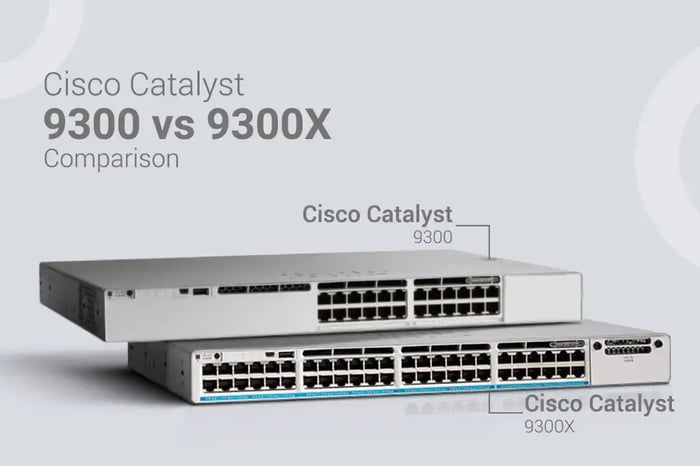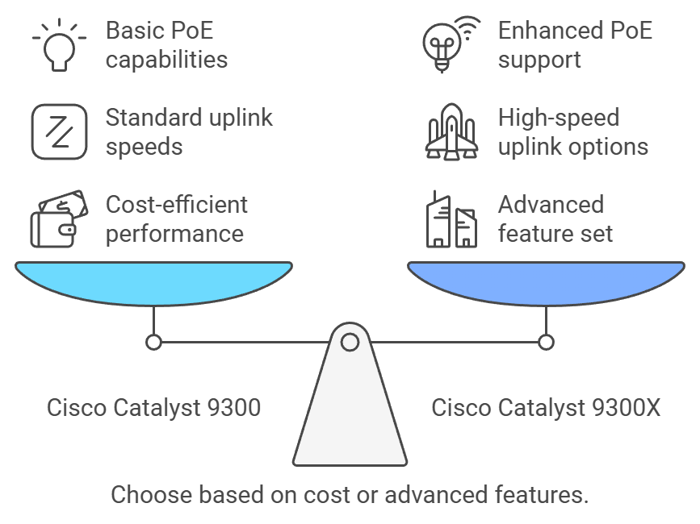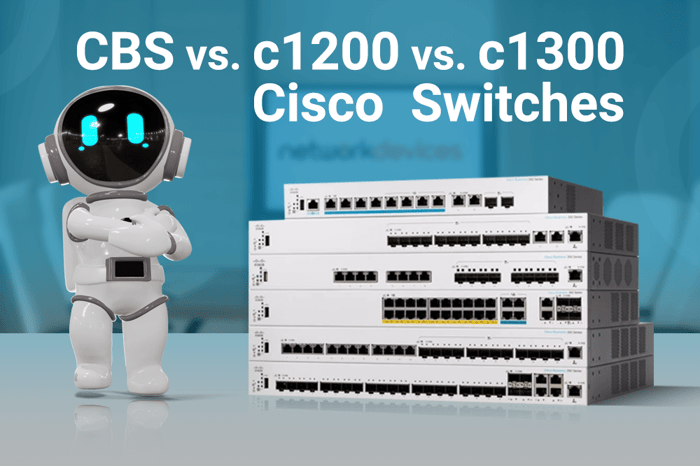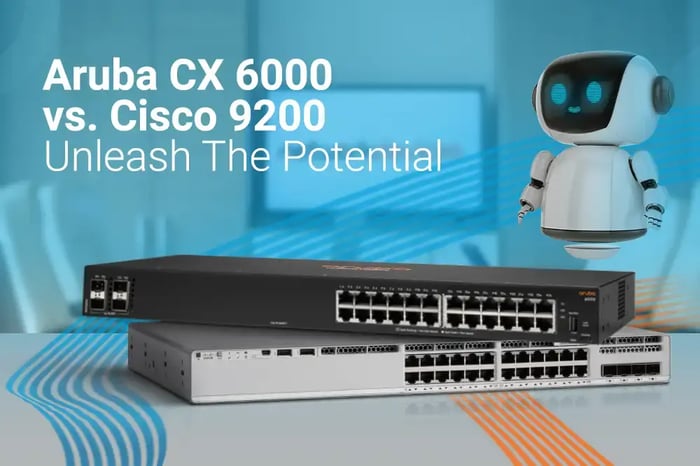You have no items in your shopping cart.

Cisco Catalyst 9300 vs 9300X: Which Switch is Right for You?
Choosing between the Cisco Catalyst 9300 and 9300X switches depends on understanding their differences in performance, scalability, and use cases.
The Cisco Catalyst 9300X is essentially an enhanced, higher-performance version of the Cisco Catalyst 9300 that provides greater scalability, higher uplink speeds, more PoE capabilities, and advanced hardware designed for data-heavy and growth-intensive environments like data centers or high-performance campus networks.
The Cisco Catalyst 9300 remains a solid choice for enterprises needing solid performance at a lower cost, while the 9300X offers superior capabilities for networks expecting higher traffic and need more power and speed.
This article provides a detailed comparison to help IT professionals and network administrators decide which switch best suits their network requirements.
Cisco Catalyst 9300 vs 9300X: Key Differences in Performance and Scalability
Uplink Options: Flexibility for High-Performance Networks
The Cisco Catalyst 9300X offers a wide range of uplink options, supporting 10G, 25G, 40G, and 100G, as well as Multigigabit uplinks. This flexibility makes it ideal for future-proofing high-speed networks and advanced applications like video streaming, AI workloads, and multi-cloud integration.
In contrast, the Cisco Catalyst 9300 supports uplink speeds of up to 40G, which is sufficient for many current enterprise needs but limited for environments anticipating higher traffic or bandwidth demands.
Stacking Bandwidth: Why 9300X's 1 Tbps Stands Out?
Stacking is essential for scalable enterprise networks, and the 9300X excels with a 1 Tbps stacking bandwidth (StackWise-1T). This is more than double the 480 Gbps stacking bandwidth (StackWise-480) of the standard 9300, enabling seamless communication and reduced latency in high-density environments.
Additionally, the 9300X supports mixed copper (1G/10G) and fiber (10G/25G/40G/100G) connections within a single stack. This flexibility makes it easier to deploy in environments requiring diverse connectivity options.
Port Density and Multi-Rate Support for Modern Networks
The Catalyst 9300X supports multi-rate ports capable of 25G/10G/1G, accommodating a wide range of devices and workloads. In comparison, the 9300 series lacks multi-rate capabilities, limiting its flexibility.
The 9300X’s high-speed and versatile port configurations are designed for dynamic, future-ready networks handling AI workloads, IoT, and server connectivity.

Key Differences: Cisco Catalyst 9300 vs. 9300X
The Cisco Catalyst 9300X series is an advanced version of the Catalyst 9300, bringing significant upgrades that enhance performance, scalability, and security features.
The improvements discussed below make the 9300X more suitable for demanding, future-proofed environments, such as large-scale enterprises and cloud-centric architectures. It is designed to address the challenges of modern networking, including high-speed connectivity, power-hungry devices, and advanced security requirements.
Performance and Throughput
The 9300X offers multi-rate 25G/10G/1G fiber ports, which can more than double throughput compared to the regular 9300, supporting higher-speed connections for modern workloads. It includes 100G/40G uplinks and achieves up to 1 Tbps stacking bandwidth, making it one of the highest stacking performance options in its class.
Application Hosting Capabilities
The 9300X has enhanced hardware to support multiple applications. It includes a more powerful CPU and RAM and the ability to host containerized applications like Docker. The addition of QuickAssist Technology (QAT) accelerates cryptographic operations for high-performance app hosting.
PoE and UPOE+ Capabilities
The Catalyst 9300X supports Universal Power over Ethernet Plus (UPOE+) with up to 90W per port, making it perfect for IoT-heavy environments such as intelligent campuses or large enterprise networks.
In comparison, the Catalyst 9300 provides 60W UPOE or 30W PoE+, which is sufficient for standard IoT devices and access points.
Stacking and Uplink Flexibility
The 9300X supports up to 1 Tbps of stacking bandwidth, significantly improving over the regular 9300. This allows for more efficient traffic management when multiple units are stacked. Additionally, the 9300X includes dual-rate uplinks (100G/40G), providing flexibility for future scalability.
Security
The 9300X integrates a crypto engine in the UADP 2.0sec ASIC, supporting up to 100G of IPsec encryption, which enhances secure connections, particularly for multi-cloud environments. It also offers advanced security features like MACsec encryption and Zero Trust Network Access.
Resiliency and Availability
The 9300X features improved power supplies, enhanced fan modules, and StackPower+ for better redundancy. Additionally, it supports hot patching and graceful insertion/removal, improving overall network uptime.
Unveiling the Power: Cisco Catalyst 9300X Enhancements Over the 9300 Series
1. Application Hosting: The Game-Changer in Networking
The Cisco Catalyst 9300X introduces increased CPU and RAM, significantly upgrading application hosting capabilities. While both the 9300 and 9300X series include a separate x86 CPU complex, the 9300X enhances this with higher RAM and CPU cores and optional SSD storage through a USB 3.0 port.
This configuration enables the 9300X to support multiple high-demand applications, including containerized apps like Docker, directly on the switch hardware, reducing the need for external servers to manage these applications.
These upgrades allow network teams to use the switch as a computing platform, with the flexibility to host applications that perform traffic analysis, intrusion detection, or advanced monitoring.
This capability is particularly useful in environments needing real-time data processing. This application hosting capability transforms the Catalyst 9300X into a multi-functional device, providing networking and computing power in a single platform.
2. UPOE+ Support for High-Powered Devices
Cisco Catalyst 9300X series switches also include Universal Power over Ethernet Plus (UPOE+) support, which allows them to deliver up to 90W of power per port.
This substantially increases compared to the standard 9300 models, which support only up to 60W of PoE (UPOE). UPOE+ enables the 9300X switches to support a broader range of high-power devices, such as next-gen wireless access points, video surveillance cameras, and advanced IoT devices
Additionally, with StackPower+ technology, the 9300X series can distribute power among stacked units, optimizing power use across multiple devices and improving redundancy.
This feature is especially beneficial in large-scale deployments, such as smart campuses or enterprise environments, where many high-powered devices need consistent and reliable power.
3. Crypto and Security Innovations in the 9300X Series
Security is a critical upgrade in the 9300X series, featuring advanced encryption and crypto capabilities not present in the 9300. The 9300X’s hardware includes a UADP 2.0sec ASIC with integrated cryptographic engines, supporting 100G of IPsec encryption throughput.
This level of security enables the switch to manage secure, high-speed site-to-site connections natively, which is essential for secure communications in multi-cloud and hybrid environments
The 9300X also supports MACsec-256 encryption at Layer 2, protecting data integrity and confidentiality across the network. Additionally, with Zero Trust Network Access (ZTNA) capabilities, the switch enforces strict access policies, ensuring that only authenticated and authorized devices can access the network.
This Zero Trust model aligns with modern security frameworks, enhancing network resilience against breaches and insider threats.
Bandwidth, Power, and Security: Why Choose Cisco 9300X Over the 9300?
Key Considerations for Selecting the Right Model
When choosing between the Cisco Catalyst 9300 and 9300X, the decision largely depends on performance needs and future scalability. The 9300 series is ideal for cost-sensitive environments or standard campus networks with sufficient basic to moderate bandwidth and port densities.
The 9300X, with its enhanced multi-rate ports, higher stacking bandwidth, and application hosting capabilities, is better suited for high-performance environments, such as large enterprises or those planning to deploy advanced technologies like AI, multi-cloud integrations, or IoT at scale.
Future-Proofing vs Cost Efficiency
The 9300X offers superior future-proofing with features like 40G/100G uplinks, 1 Tbps stacking bandwidth, and 25G multi-rate ports that accommodate emerging technologies. However, this advanced performance comes at a higher upfront cost.
On the other hand, the 9300 is more cost-efficient, delivering solid performance for most current enterprise needs, making it a more affordable choice for organizations that don’t yet require the cutting-edge features of the 9300X
Use Cases for Enterprise and Campus Networks
For enterprise networks, the 9300X is ideal in environments demanding high bandwidth, security, and flexibility—such as large data centers, multi-site networks, and cloud-centric infrastructures. Its advanced security features, higher power delivery (UPOE+), and increased stacking capabilities make it a perfect fit.
In contrast, the 9300 excels in campus networks or small to medium-sized enterprises with standard performance needs, where budget constraints and less intensive data throughput are more of a focus.

Choosing the Right Switch
The Cisco Catalyst 9300 provides solid performance for today's enterprise needs at a lower cost, while the 9300X stands out with advanced features for future-ready, high-performance networks. Whether you prioritize cost-efficiency or cutting-edge technology, choosing the right switch depends on your network's current demands and long-term goals.
You can check our collection page or Cisco's datasheet for more information.






